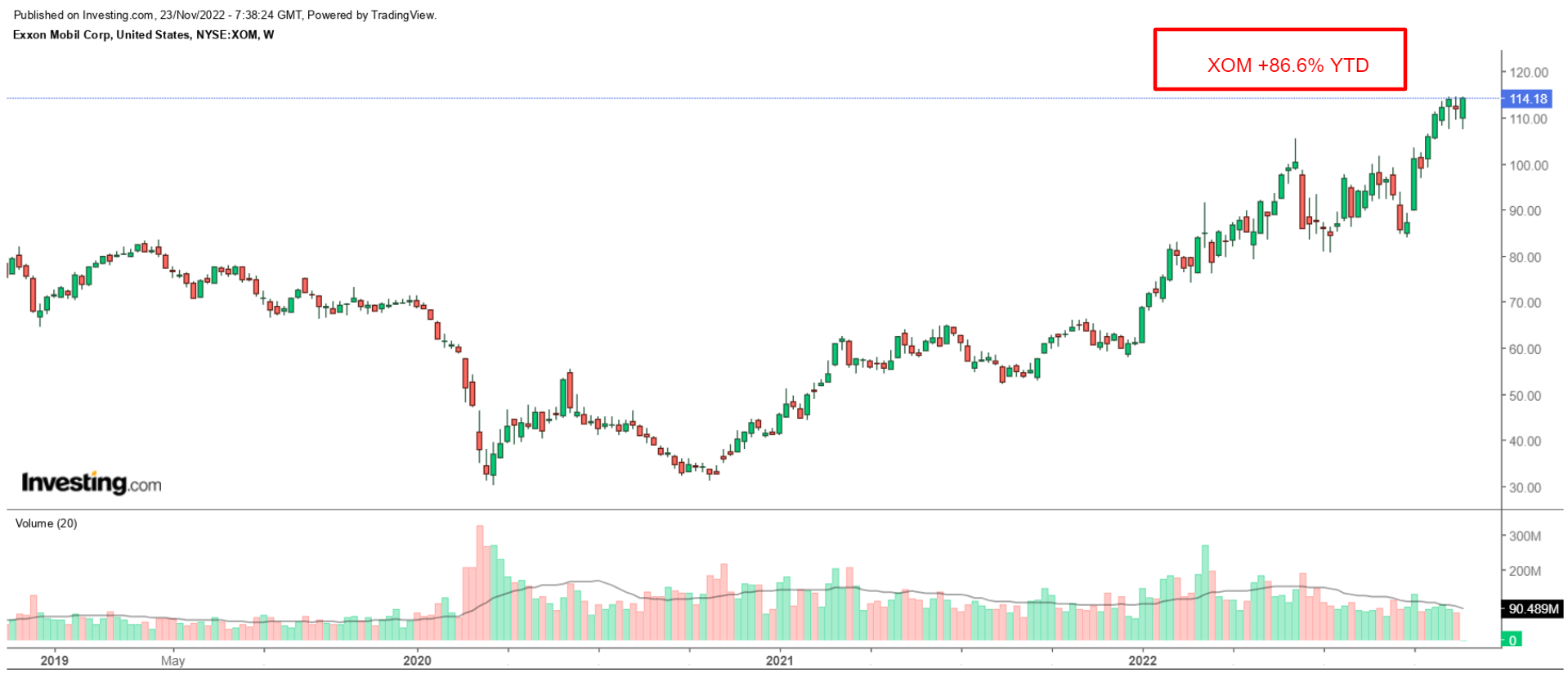- Rising rates, accelerating inflation, and slowing economy hammered S&P 500
- Energy and healthcare shares have been the market’s top gainers
- Investors should consider buying Exxon Mobil and Merck
With just 25 trading days left in 2022, U.S. stocks are on track to record one of their worst annual performances in recent history, hammered by fears the Federal Reserve’s aggressive rate hikes to combat inflation will tip the economy into recession.

The S&P 500 is down 15.8% year-to-date (ytd) and roughly 17% away from its Jan. 3 record close. The tech-heavy Nasdaq Composite, which has languished in bear market territory for most of the year, is off by 28.6% ytd and is 31% below its Nov. 19, 2021 all-time high.
Meanwhile, the blue-chip Dow Jones is down the least, declining 6.1% ytd, and is approximately 7.7% off its record peak reached at the start of the year.
Despite the months-long selloff, energy titan Exxon Mobil (NYSE:XOM) and healthcare giant Merck (NYSE:MRK) have offered investors a bit of a relief, shining in an otherwise challenging market at the expense of the high-growth tech winners of yesteryear.
Undoubtedly, investors who caught the sharp moves higher are extremely grateful this time of year. For those who missed out, I recommend buying XOM and MRK, given their profitable business model, healthy balance sheet, and enormous cash pile.
Exxon Mobil
- Year-To-Date Performance: +86.6%
- Market Cap: $471.1 billion
2022 has been a banner year for Exxon Mobil. Shares of the Irving, Texas-based company, which began trading at $61.19 on Jan. 1 and rose all the way to a record high of $114.66 on Nov. 8, have gained 86.6% year-to-date amid a furious rally in crude oil and natural gas prices.
U.S. crude is up nearly 15% this year, with prices jumping to their highest level since 2008 at one point amid a disruption to global supplies following Russia's invasion of Ukraine in February. Meanwhile, U.S. natural gas prices, which climbed to a 14-year peak in late August, are up about 85% since the start of the year.
At current levels, Exxon, which has significantly outperformed its major competitors—Chevron (NYSE:CVX) (+58.4% ytd), Shell (NYSE:SHEL) (+30.9% ytd), TotalEnergies (NYSE:TTE) (+21.4% ytd), and BP (NYSE:BP) (+31% ytd)—is the eighth most valuable company listed on the U.S. stock exchange.
In my opinion, XOM remains one of the best stocks to own heading into the new year thanks to the company’s ongoing efforts to return capital to shareholders amid a strong balance sheet and high free cash flow levels. It also boasts a relatively cheap valuation.
The oil-and-gas behemoth reported record quarterly profit of $19.7 billion last month, almost matching the $20.7 billion earned by Apple (NASDAQ:AAPL) over the same period. It made approximately $43 billion in profit throughout the first nine months of 2022, up 19% year-over-year.
Indeed, Exxon said it returned $8.2 billion to its stockholders in the July-Sept. period, including $3.7 billion of dividends and $4.5 billion of share buybacks. The company has repurchased $10.5 billion of its own stock so far this year, consistent with its plan to buy back up to $30 billion of shares through fiscal 2023.
I believe that Exxon is well placed to extend its strong performance as it continues to benefit from robust commodity prices and increased output at its stellar operations throughout the Permian basin.
With a price-to-earnings (P/E) ratio of 9.0, the stock is undervalued given the company's growth prospects.
Merck
- Year-To-Date Performance: +39.5%
- Market Cap: $270.5 billion
Merck’s stock has been a bright spot on the S&P as investors pile into the thriving healthcare name. Shares of the Rahway, New Jersey-based pharmaceutical giant, which climbed to an all-time peak of $107.09 last night after starting the year at $76.64, are up 39.5% year-to-date.
The drugmaker is the top-performing stock of the year amongst names found in the Health Care Select Sector SPDR® Fund (NYSE:XLV), outpacing the annual performance of major industry peers, Johnson & Johnson (NYSE:JNJ) (+3.3% ytd), Eli Lilly (NYSE:LLY) (+30.6% ytd), AbbVie (NYSE:ABBV) (+18% ytd), and Pfizer (NYSE:PFE) (-16.8% ytd), thanks to robust demand for its blockbuster drugs.
Merck owns six blockbuster drugs, each with over $1 billion in revenue, most notably its cancer immunotherapy Keytruda, human papillomavirus vaccine Gardasil, and diabetes treatment Januvia.
Merck is well positioned for further gains in the coming months as it continues to benefit from strong fundamentals, which will help fuel future growth in earnings and free cash flow, allowing it to maintain its focus on shareholder returns.
It has beaten profit and revenue forecasts in each quarter so far this year and as of the end of September, the pharma giant had more than $11 billion in cash.
Stocks of high-quality defensive companies whose products are essential to people’s everyday lives, such as drug manufacturers, tend to perform well in times of economic downturns as they boast high free cash flow, low debt levels, and down-to-earth valuations.
Indeed, with a forward P/E ratio of 14.1, and an annualized dividend of $2.76 per share at a relatively elevated yield of 3.20%, Merck stock still has plenty of room to extend its march higher, making it a solid investment with strong long-term growth prospects.
Disclosure: At the time of writing, Jesse is long on the Dow Jones Industrial Average, S&P 500, and Nasdaq 100 via the SPDR Dow ETF, SPDR S&P 500 ETF, and Invesco QQQ ETF. He is also long on the Energy Select Sector SPDR ETF and the Health Care Select Sector SPDR ETF. The views discussed in this article are solely the opinion of the author and should not be taken as investment advice.
